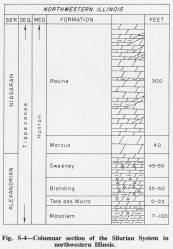Sweeney Formation
Lithostratigraphy: Hunton Limestone Megagroup >>Sweeney Formation
Chronostratigraphy: Paleozoic Erathem >>Silurian System >>Alexandrian Series
Allostratigraphy: Tippecanoe Sequence
Primary source
Willman, H. B., Elwood Atherton, T. C. Buschbach, Charles Collinson, John C. Frye, M. E. Hopkins, Jerry A. Lineback, and Jack A. Simon, 1975, Handbook of Illinois Stratigraphy: Illinois State Geological Survey Bulletin 95, 261 p.
Contributing author(s)
H. B. Willman and Elwood Atherton
Name
Original description
Derivation
The Sweeney Formation is named for the Sweeney Islands in the Mississippi River, a short distance west of the type section.
Other names
History/background
Type section
Type location
The type section of the Sweeney Formation is located in an exposure in the bluffs in Mississippi Palisades State Park, north of Savanna, Carroll County (SW SE NE 33, 25N-3E), where the formation is 55 feet thick. It is also well exposed in the Mississippi River bluffs south of the Savanna Anticline and in quarries at Fulton in Whiteside County (cen. NE SW 21, 22N-3E).
Type author(s)
Type status
Reference section
Reference location
Reference author(s)
Reference status
Stratigraphic relationships
The Sweeney Formation (Willman, 1973, p. 36) (fig. S-4) overlies the Blanding Formation in northwestern Illinois.
Extent and thickness
The Sweeney Formation is commonly 45-55 feet thick and occurs throughout the Silurian outcrop area in northwestern Illinois, although it is eroded from most of the mounds north of Hanover.
Lithology
The Sweeney Formation is light pinkish to brownish gray, vesicular, pure dolomite in tight beds 1-4 inches thick with thin, green clay partings. Near the base and in a zone near the middle of the formation, the partings become thicker and are shaly. In places the formation contains no chert, but scattered nodules are not rare, and in a zone 3-5 feet thick 15-20 feet above the base the chert occurs in layers, lenses, and nodules.
Core(s)
Photograph(s)
Contacts
Well log characteristics
Fossils
Microcardinalia and Pentamerus oblongus are common in the Sweeney Formation, generally in the chert. Silicified corals are common throughout the formation.
Age and correlation
Savage (1926) correlated this unit with the Niagaran Joliet Formation in northeastern Illinois, but it has slight lithologic resemblance to the Joliet, is similar to the Kankakee Formation, and contains the Microcardinalia Zone characteristic of the upper Kankakee. It is equivalent to the upper part of the Hopkinton in Iowa and it is tentatively correlated with the Kankakee and the Sexton Creek Formations elsewhere in Illinois.
Environments of deposition
Economic importance
Remarks
References
SAVAGE, T. E., 1926, Silurian rocks of Illinois: Geological Society of America Bulletin, v. 37, p. 513-533.
WILLMAN, H. B., 1973, Rock stratigraphy of the Silurian System in northeastern and northwestern Illinois: Illinois State Geological Survey Circular 479, 55 p.
ISGS Codes
| Stratigraphic Code | Geo Unit Designation |
|---|---|
